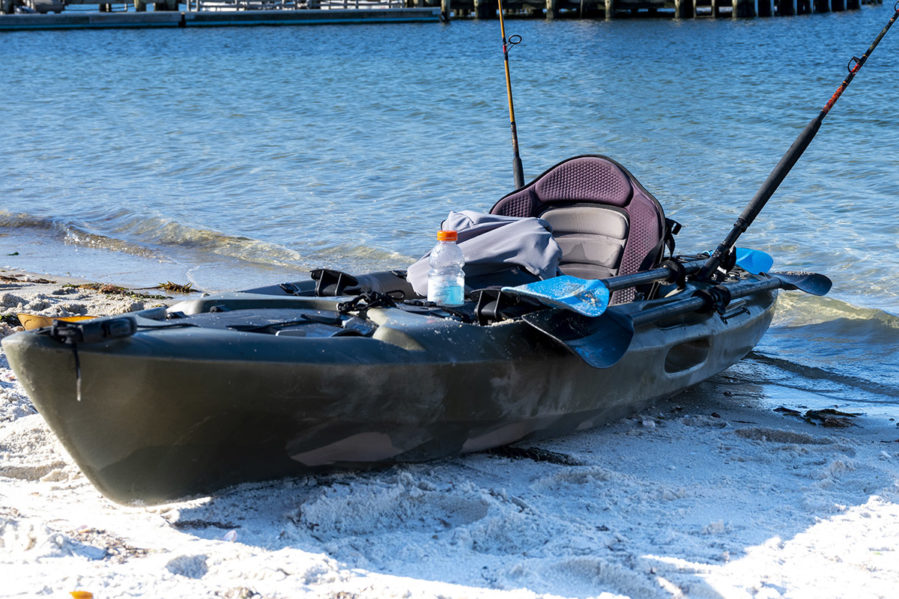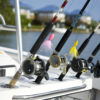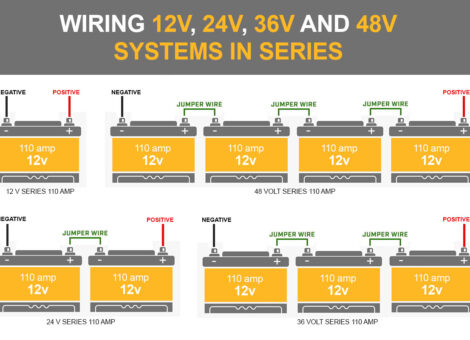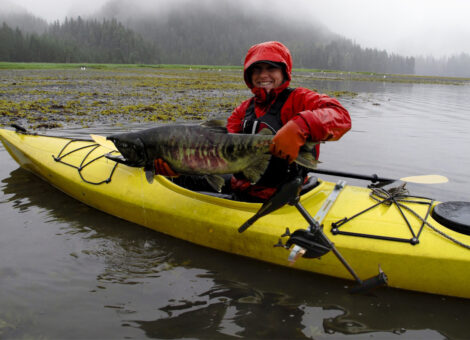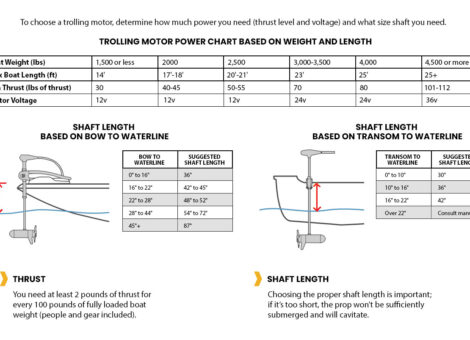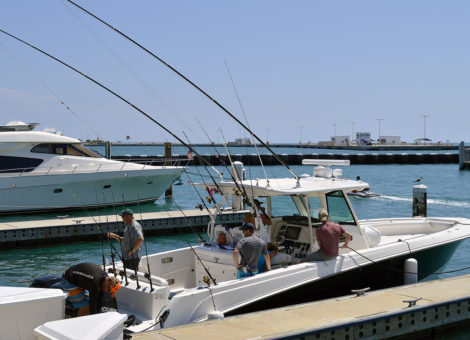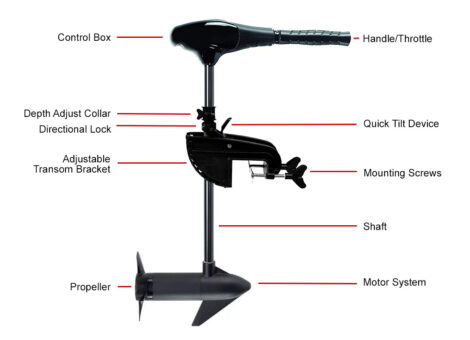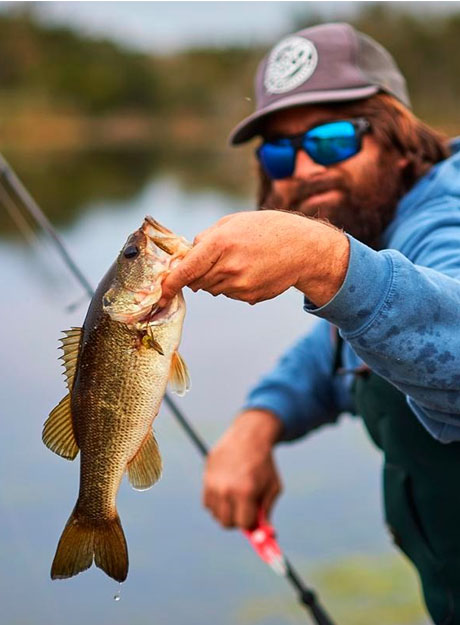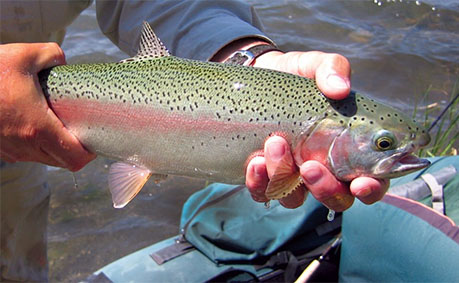Kayak fishing is on fire and it’s no suprise why. Kayaks are much less expensive than traditional fishing boats, more stable on the water than canoes, they’re highly portable, low maintenance, and extremely convenient. How many times have you put off a fishing trip because you just aren’t in the mood to rig up your 22 foot center console and compete with every other weekend warrior for a spot on the lake. Kayaks are ideal for the urban angler who wants to be out on the water by noon and back home prepping the fish fry by 5 o’clock.
Kayaks are also extremely “small water” friendly. They can access some of the most remote and inaccessible waters. There are countless access points and fishing opportunities for kayak anglers. But the real appeal of kayak fishing is that you’re right down on the water where the fish are. For the true naturalist and outdoorsman, there’s nothing more exilerating than being one with nature, one with the water, and smack dab in the middle of the action! Try reeling in a 157-pound blue from a 10 foot 51 pound Tamarack and tell me it ain’t so.
So now that you’re sold, it’s time to run down to Walmart and take advantage of the end-of-summer kayak closeout special, right? Not exactly. Let me just say—and I speak from experience—when it comes to fishing kayaks, you get what you pay for. It’s not to say that you can’t pick up a quality kayak at a good price, but you really want to know what you’re buying—and understand ahead of time what you’re buying it for.
Selecting a fishing kayak is fairly straight forward. But you either have the experience to know what to look for, or you don’t. This guide is intended primarily for the first time kayaker who is exploring taking up kayak fishing as a weekend pastime, but we’ll include some golden nuggets as well for the more experienced kayak angler who may be looking to make an upgrade—and take his game to the next level.
As you approach purchasing your first fishing kayak, or look to upgrading your current setup, consider the following questions:
- Fishing Location: Where are you planning to fish? Will you be in fast-moving water, like creeks and rivers, or slow-moving water like a calm lake? Will you be fishing nearshore bays and flats, or deeper open water?
- Kayak Type: Do you prefer a traditional sit in kayak or one where you sit on top? Do you prefer a rigid structure, or something that’s inflatable? If you’re limited on space, an inflatable kayak is your best bet, but they are more difficult to get into and out of.
- Propulsion Options: How are you going to move your kayak around on the water? Do you plan to paddle, pedal, or use a motor? While some people enjoy paddling, it’s easier to pedal so you can keep your hands free to hold your fishing rod. Do you prefer a trolling motor so you can fish farther from shore?
- Amount of Gear: Do you plan to bring a lot of gear with you, or just a small amount? Think about your size and weight, then factor in the amount of gear you plan to bring. Use this information to find a kayak that has the weight capacity and space to handle everything.
- Standing or Sitting: If you want to be able to stand up when you you fish, you’ll want to make sure you get a kayak that is stable. Generally, the wider the hull, the more stable the kayak. However, the tradeoff for a wider hull is a slower kayak.
- Transporting your kayak: How are you going to get your kayak to the fishing location? If you have a truck, you may be able to put it in the bed. However, if you have a car, you’ll need to decide if you want to attach it to the top or get a trailer. Will you be fishing alone or with someone else? If fishing alone, you’ll want a kayak you can transport by yourself.
- Design Features: What type of kayak catches your eye? Kayaks come with many different features and in a variety of designs. Consider the length, width, hull design and material – all of these can have an impact on how the kayak performs on the water.
- Budget: How much can you afford to spend on your kayak? The smart option is to decide on your budget before you head out to shop, then choose something that falls within that price range. The cheaper fishing kayaks will run you around $800, where the more expensive versions will cost you $1,200 or more.
Where Are You Going to Be Fishing?
The first thing to consider when purchasing a a fishing kayak is where you’ll be fishing. You’ll need to think about things like how fast the water will be moving. If you plan to fish on a fast-moving river or creek that may contain rapids, you’ll need a kayak that is shorter and easier to maneuver. Look for something less than 12 feet long. If you’ll be fishing in a larger body of water where you need to cover a lot of distance, opt for something between 12 and 16 feet long. And if you’re headed out to the open ocean, choose a long, thin kayak that lets you easily paddle out into the deep waters. Generally, this means choosing something longer than 16 feet.
If you plan to fish in a variety of locations, choose a kayak based on where you’ll be doing the majority of your fishing. Here are some things to consider depending on your preferred fishing location:
- Lakes and Ponds: For fishing calm bodies of water with slow moving current a sit in or sit-on-top kayak between 9 and 11 feet that offers a wide hull will provide good stability and allow for standing.
- Rivers and Streams: When fishing smaller, tighter locations, like creeks and rivers, you’ll want to choose a shorter kayak so you can move around obstacles more easily.
- Ocean: If you’re up to braving the waves, currents and tides of the ocean, should opt for a kayak that is equipped with a rudder system to help you maneuver in the rougher waters. You’ll also want a kayak that is slightly longer (13′-15′) to provide extra stability.
- Open Water: If you plan to fish in a large, open body of water that requires you to paddle long distances, such as a large lake, look for a long, skinny sit-on-top kayak. These tend to move fast and easily cover a lot of distance.
Types of Fishing Kayaks
No question that ‘type’ is your biggest consideration when purchasing a kayak for fishing. There are three main types of kayaks: sit-on-top, traditional sit-ins and inflatable.
Sit-on-top Kayaks
While you can catch fish from just about any kayak, sit-on-top kayaks are hands down the #1 choice of kayak for anglers.

What makes sit-on-tops the number one choice for fishing?
- They’re easy to get in and out of when launching, when exiting, and if you happen to fally out in the water.
- They tend to more stable, which means you can fish either sitting down or standing up. This versatility makes casting and reeling easier.
- They sit higher in the water, which lets you keep your eye out for fish, structures or obstacles.
- They have scupper holes that allow the water to automatically bail out, so you don’t need to pump it out yourself.
- Sit-on-tops offers the largest variety of seating options for maximum comfort. Many angler reports spending on the upwards of 12 hours seated comfortable. (Not going to happen in a sit-in kayak.)
- They let you move around freely so you can easily access your storage, hatches, and equipment.
- There are variety of storage options that come standard or that can be added to sit-on-top kayaks. When you’re out on the water for extended periods of time you want to be able to bring all your gear with you.
- They’re very customizable. You can rig a sit-on-top to meet your exacting needs.
It think the only downside is cost. You are going to spend a bit more purchasing a sit-on-top than you will with kayak styles. I paid about $2,000 for may sit-on-top (gear not included), and it was worth every penny.
For a quality sit-on-top fishing kayak expect to spend in the range of $1,000 to $2,000. We reviewed the prices for about 50 solid sit-on-tops and the median price was just over $1,300.
Sit-in Kayaks
I wouldn’t recommend the sit-in style kayak for fishing, but it may be something you want to consider.

Sit-in kayaks aren’t very angler friendly for several reasons.
- They’re not easy to get in and out of—especially in a pickle.
- They’re not self bailing. If they fill up with water you’re toast.
- They sit low in the water—often below the surface. This makes it difficult to get a good view of the water.
- They often have a standard seat that isn’t especially comfortable in my opinion. I would not enjoy spending more than a couple hours (at most) fishing from sit-in kayak.
- You’re in one position almost the entire time you’re in the kayak.
- They’re not very customizable.
One of the biggest benefits of sit-ins over other types of kayaks is cost. They tend to be less expensive than higher end alternatives. They also offer protection for your legs and gear.
If you buy a sit-in kayak, it will usually come with a spray skirt that is designed to keep the seating area free of water—but most anglers will opt to not use it.
Inflatable Kayaks
Inflatable kayaks are great for anglers with limited carrying capacity since they require minimal room to transport. They’re popularity really lies in their portability.
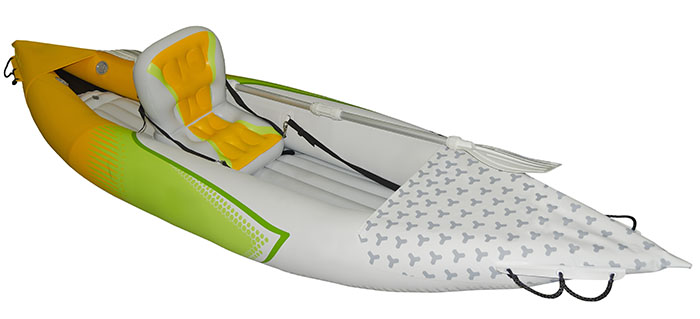
The following are the most important considerations when purchasing an inflatable kayak for fishing.
- They tend to be more stable, which means you can fish from either a sitting or standing position. This makes them more versatile and helps make it easier to cast out your line or fight a large fish.
- They have scupper holes that allow the water to automatically bail out, so you don’t need to pump it out yourself.
- Like hard body sit-on-top kayaks, inflatables position you higher in the water, allowing you a better view point.
- They allow you to move around freely and access storage areas and equipment.
- They aren’t as durable as traditional kayaks. You have to watch out for rocks, sticks or even sharks if fishing in the ocean. (I personally would never fish in the ocean in an inflatable anything.)
- They tend to be more difficult to paddle and can be slower than hard plastic models.
If you choose to fish in an inflatable kayak, make sure you also purchase a good-quality pump and a patch kit to go along with it.
Propulsion Options
When most people think of kayaks, they picture something you paddle. However, modern kayaks can come with a pedal drive system or even a motor.
Paddle Kayaks
Your most basic and obvious propulsion option is a traditional paddle kayak. It’s simple to use and less expensive. Paddle kayaks don’t have extra mechanisms, so they tend to be lighter, which makes them easier to carry. And since they don’t have any moving parts—other than the paddler—they’re much less prone to breaking.
Paddle kayaks also sit high on the water, which means you can use them to fish even the shallowest areas. Plus, by using a paddle, you’re able to combine fishing with exercise, which is something that many anglers find appealing.
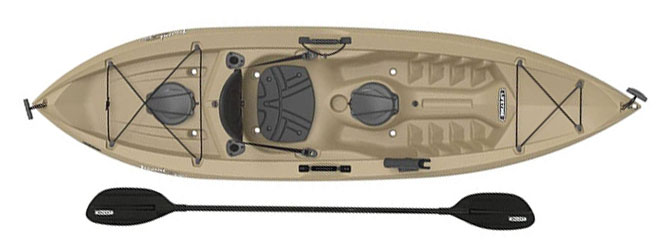
As popular as traditional kayaks are, they have a few downsides. One of the biggest drawbacks to using a paddle kayak for fishing is it must be paddled using your arms. An angler can’t maneuver the kayak and fish at the same time. Range is also limited to the physical stamina of the angler.
Biggest benefits of paddle kayaks for fishing:
- Least expensive option
- Light and highly portable
- Less prone to breaking
- Can access shallow water
- Great for quick trips and hard-to-reach spots
Again, the biggest drawback to using a paddle kayak for fishing is that your arms are not always for free for casting or reeling.
Pedal Kayaks
In a similar fashion to a paddle boat, a pedal kayak allows you to move the kayak by pedaling with your feet. You simply pedal like you would a bike, which rotates the prop and propels the kayak through the water. To steer a pedal kayak anglers use a hand-operated rudder.
Pedal kayaks are an appealing option for fishing because they allow you to maneuver the kayak using your legs and feet while your arms and hands are free for casting and reeling. With a little foot work these kayaks will glide at a consistent speed, which makes them good for trolling.
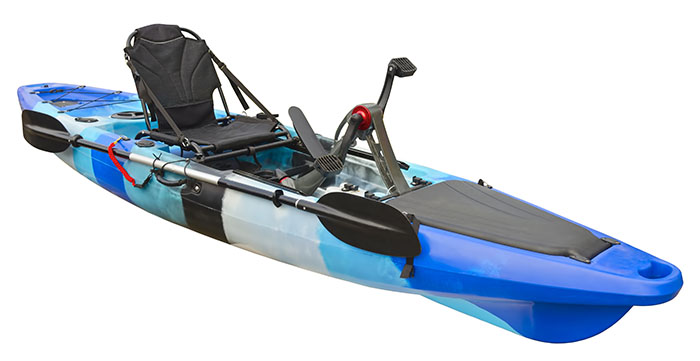
Pedal kayaks are a really great option, just be aware that due to their features, pedal-powered kayaks are harder to maintain and cost more than paddle kayaks. The pedal mechanism can also make it harder to fish in shallow water. Still, these kayaks have plenty of positives.
Biggest benefits of pedal kayaks for fishing:
- Arms are free for casting and reeling
- Requires less effort to propel through the water
- Ideal for open water and long distance
- Go faster and farther than paddle kayaks
- Very stable and offer more storage
- Can be used for trolling
If you’re going to go human powered, pedal kayaks are a great way to get around on the water. However, as convenient as they are, if you’re planning on fishing rivers, shallows, or weed-choked lakes, a paddle kayak is still going to be the better option.
Motorized Kayaks
Many modern fishing kayaks now come with an electric motor, or with the ability to install an after market trolling motor using a kit. Motorized kayaks are perfect for anglers looking to cover a lot of water with ease and speed, but who also enjoy the agility and stealth offered by a traditional kayak.
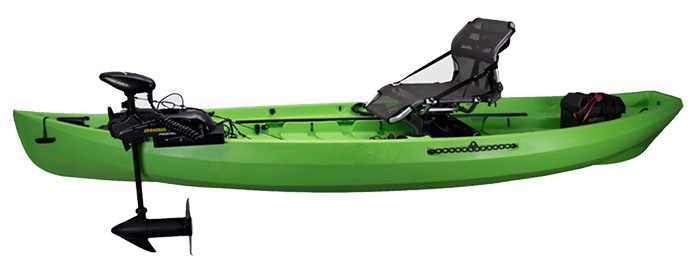
There are a few drawbacks to using a motorized kayak, such as weight, cost of maintenance, and price tag, but honesty, the advantages outweight the disadvantages by a mile. I don’t know any angler who has gone back to a paddle or pedal kayak after using or owning a motorized kayak. Motorized kayaks open a whole new world of opportunity and adventure for serious anglers.
Biggest benefits of motorized kayaks for fishing:
- Best way to kayak fish hands-free
- Covering longer distances without fatigue
- Ability to move to different spots quickly
- Ability to haul more gear and heavier payload
- Spend more time fishing and less time traveling
- Autopilot for holding position in wind and current
- Anchor lock and cruise control options
- GPS auto-routing technology for plotting and following routes
- Ideal for trolling
You do have to watch out that your prop doesn’t hit bottom when fishing shallow water, but many motors can be tilted up to avoid this. And there are a variety of weedless prop options for fishing heavy vegetation and weeds.
Word to the wise… even if you end up getting a motorized kayak never leave shore without a paddle. Mechanical failure or a dead battery is a foregone conclusion. At some point you’re motor will fail you for whatever reason and the last you thing you want is to be ten miles out on the water without a way to get back. There are also times a good paddle is needed to get you through the weeds or over the shallows.
If you’re going to go with a motorized kayak there are a number of trolling motor options to consider. When selecting a trolling motor there are 5 basic considerations.
- Thrust requirement
- Shaft length
- Battery type/size
- Mounting system
- Propeller size
How Much Gear Are You Going to Be Hauling?
When it comes to gear, some angler like to keep things simple and pack light, while others take everything under the sun with them. If you’re one of those who likes to bring a lot of gear, make sure you choose a kayak that has the space to handle all of it. On the other hand, if you don’t like to carry much equipment, you don’t need to be as concerned about space.
But space isn’t the only thing to think about when it comes to gear. You’ll need to take the boat’s weight capacity into consideration as well as your own weight and that of your gear. Try to determine a rough estimate of how much weight the boat will need to hold, then choose a kayak rated for those requirements. If you don’t buy a boat rated for your weight requirements, you may end up in a potentially dangerous situation.
The following chart provides an estimate for the weight capacities of different types of kayaks.
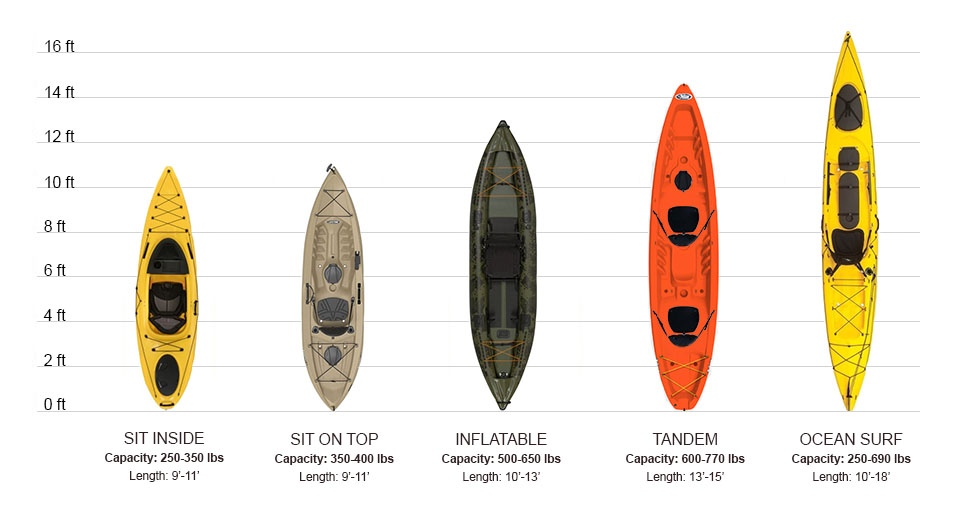
| Sit Inside | Sit On Top | Inflatable | Fishing Tandem | Ocean Surf | |
|---|---|---|---|---|---|
| Length | 9'-11' | 9'-11' | 10'-13' | 13'-15' | 10'-18' |
| Weight Capacity (lbs) | 250-350 | 350-400 | 500-650 | 600-770 | 250-690 |
Standing While Fishing
If you’re a fisherman who likes to stand up in your kayak and fish, you’ll want to take a close look at the cockpit of the kayak you’re considering. Some offer footwells specifically designed to make it easier to stand, while others give you the ability to add assist straps or support bars.
Another very important thing to consider for standing is the stability of the boat. As a general rule of thumb, the wider the boat, the more stable it is to stand on. A wide boat will be easier to stand up on, and once you’re up, it will be easier to keep your balance while you fish. There are other things that can affect a kayak’s stability, such as hull design. Some manufacturers have even found ways to make a boat more stable without increasing the size. Your best bet is to go for the wider kayak just to be sure.
How Are You Going to Transport Your Kayak?
It’s not enough just to buy a great kayak – you still have to be able to transport it. Think about the type of vehicle you own and what size it can handle. There’s also the option of buying a separate trailer for your kayak so you don’t have to put it on the top of your car.
If you aren’t planning to buy a trailer and you don’t have a truck bed to put it in, you’ll have to transport your kayak on the top of your vehicle. This means you’ll need to choose something that is not only the appropriate size, but also easy to carry and handle. This is especially true if you plan to go fishing alone. You don’t want to get stuck somewhere and realize you’re unable to get your kayak back on your car.
The following chart provides the average length and weights of different types of kayaks. This will give you an idea of the transportation requirements for each kayak type.
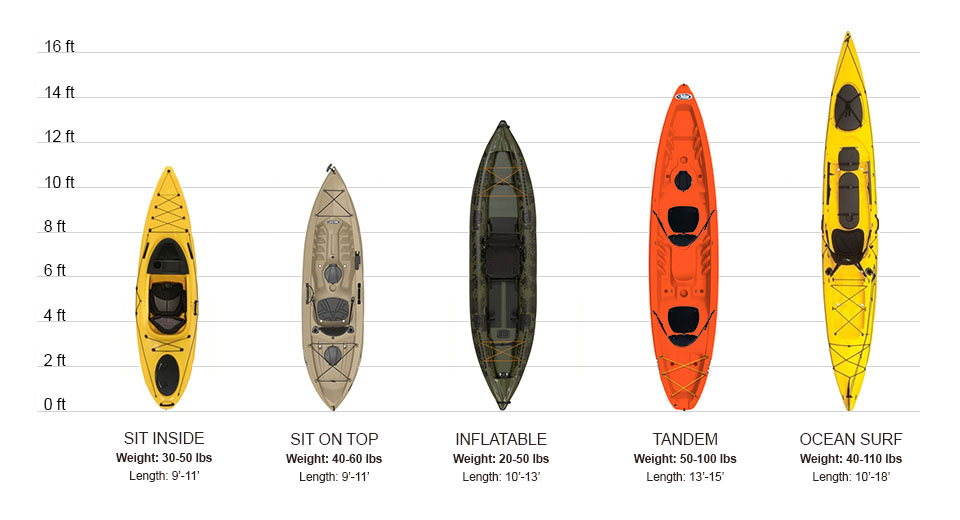
| Sit Inside | Sit On Top | Inflatable | Fishing Tandem | Ocean Surf | |
|---|---|---|---|---|---|
| Length | 9'-11' | 9'-11' | 10'-13' | 13'-15' | 10'-18' |
| Kayak weight (lbs) | 30-50 | 40-60 | 20-50 | 50-100 | 40-110 |
Design and Performance Features
Kayaks come with many different design and performance features – all of which have different purposes. The main things to consider are hull design, length, width and materials.
Hull Design
A kayak’s hull design generally affects its performance. For example, look down the center on the bottom of the kayak. Does it have a large, pronounced keel? If so, that kayak is made to glide easily in a nice, straight line in the water. Is the bottom rounded? If it is, it will be able to turn easily, but won’t be very easy to stand up in.
Primary stability and secondary stability are the most important things to consider when looking at a kayak’s hull. Primary stability refers to how difficult it is for you to turn a boat to the point just before it flips over. Secondary stability refers to how much effort is takes to flip the boat over after it reaches that initial point.
Length (Speed)
Length is the feature that correlates most to the kayak’s speed. In general, the longer a boat is, the faster you’ll be able to get it to move when you paddle. When it comes to a boat’s speed, many other features can factor into the equation, like weight and hull design. But all those things being equal, the longer boat will be able to move faster. This option is best suited for those who plan to use their kayak in large bodies of water or in places with large tides. Be aware, however, that the thinner the boat, the easier it is to tip over.
If you aren’t covering a lot of ground and need something more nimble, you’ll want to think about getting a shorter boat. These boats turn much more easily and can maneuver around rocks and other obstacles. If possible, see if you can try out several different types of boats to see which one works best for you.
Width (Stability)
The easiest way to check the stability of a boat is to look at its width. Generally, the wider it is, the more stable it will be. This is especially important for those who plan to stand up in their kayaks and fish. But width isn’t the only thing that determines stability. Many factors, such as hull design can affect a kayak’s stability. But in general, the width is the easiest way to determine how stable a kayak will be.
Materials
Kayaks can be made of many different materials. Here are just a few of the options you’ll find:
- Rotomolded Plastic is the most common material used for kayaks is rotomolded plastic. This material is easy and cheap for companies to produce and is also durable. These kayaks are meant to take the abuse of hitting trees, rocks and other obstacles without being ripped apart. They’re a great option for those who are looking for something that can take a beating. However, if you’re looking for something that is lightweight, you may want to consider other materials. Just be aware that the lightest kayaks are generally not the most durable.
- Thermoformed Plastic is a newer material that is popular with many sea kayakers due to its ability to produce a fast, lightweight boat. They tend to be coated with a very shiny finish, which makes them very appealing to those looking for something a little sexier.
- Wooden Kayaks known for their beauty are often coveted by traditionalists who enjoy a more natural material. You won’t find many wooden fishing kayaks, but you may be able to hunt down a canoe or sea kayak made of this natural resource. Because wooden kayaks are so beautiful and rarely seen, don’t be surprised if they inspire envy from other people on the water who don’t have one.
How Much Do You Want to Spend on a Fishing Kayak?
Your budget should be a big driver in which kayak you choose. Before heading out to the store, it’s advisable to look over your finances and determine what you can afford to spend. This way, when you get to the store, you can limit yourself to looking only at kayaks that fit within your budget.
There are generally three price levels for kayaks. Your budget versions will cost you around $800 or less. The mid-range kayaks are generally priced between $800 and $1,000. And for those who have a little more to spend, there are the high-end kayaks – these will run you upwards of $1,200.
Budget Kayaks (Less than $800)
While they may be less expensive, budget kayaks are still a great option. The most important things to consider are comfort and transport – and as long as your boat meets those requirements, you’re good to go. Even budget kayaks can have some great features. Just be sure to try out the kayak on the water, if possible, before buying it.
Mid-range Kayaks ($800-$1200)
As you’d expect, paying more for a kayak gets you better features. Kayaks that fall in the mid-range generally have more features than budget kayaks, but less than the high-end kayaks. If this is your price range, you’ll have a good selection of models, features and designs to choose from.
High-end Kayaks ($1200 or more)
If money is no object, why not splurge on a high-end kayak? By buying something more expensive, you’ll be sure to get your choice of the best features, models and designs. But don’t just choose something because of the price tag – make sure you’re getting your money’s worth and only splurging on items you really need. If you aren’t really sure if you’ll like kayak fishing, or don’t plan on doing it very often, it may make more sense to opt for a less expensive version. At the very least, check out the less expensive options. You may just find something that is perfect for you.
You can usually identify a higher-priced kayak from its many features and fancy designs. It’s on these expensive models that you’ll find all sorts of bells and whistles, such as comfortable seats, rod holders, gear track and wiring for electronics. If you can imagine it, these kayaks probably have it. Another positive about high-end models is that they tend to be very durable and have well-made hulls, which means they should last you a long time.
When you’re ready to buy your kayak, you could head down to the nearest sporting goods store, but you’d do much better going to a real paddle shop. The people employed at these stores generally know much more about kayaks and can help match you up with your ideal boat. Make sure you give them a lot of information and ask plenty of questions. The better they understand your situation and needs, the more likely you’ll end up with a purchase that makes you happy. These shops also often have something called a demo day where you can test out the kayaks before deciding which one you want to buy.


